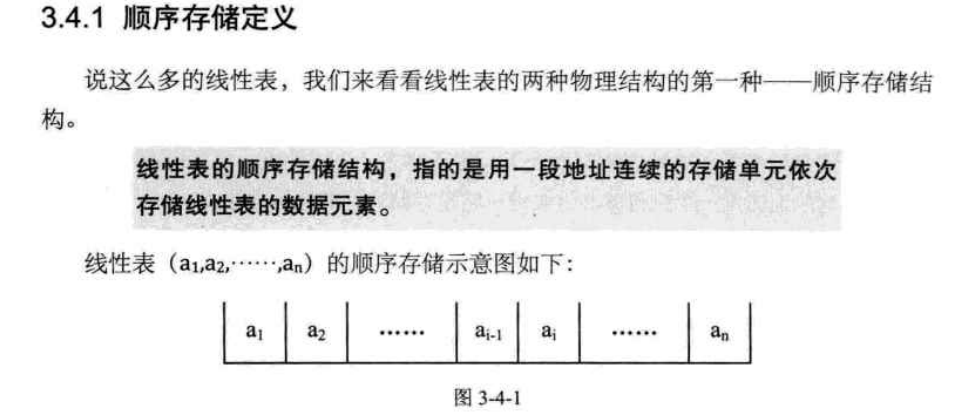基本概念
设计与实现
| 插入元素算法 判断线性表是否合法 判断插入位置是否合法 把最后一个元素到插入位置的元素后移一个位置 将新元素插入 线性表长度加1 |
| 获取元素操作 判断线性表是否合法 判断位置是否合法 直接通过数组下标的方式获取元素 |
| 删除元素算法 判断线性表是否合法 判断删除位置是否合法 将元素取出 将删除位置后的元素分别向前移动一个位置 线性表长度减1 |
代码:
</pre><pre name="code" class="cpp">// seqlist.h
#ifndef __MY_SEQLIST_H__
#define __MY_SEQLIST_H__
typedef void SeqList;
typedef void SeqListNode;
//链表 创建
SeqList* SeqList_Create(int capacity);
//链表 销毁
void SeqList_Destroy(SeqList* list);
////链表 清空
void SeqList_Clear(SeqList* list);
//链表 长度
int SeqList_Length(SeqList* list);
//链表 容量
int SeqList_Capacity(SeqList* list);
//链表 在某一个位置 插入元素
int SeqList_Insert(SeqList* list, SeqListNode* node, int pos);
//获取某一个位置的链表结点
SeqListNode* SeqList_Get(SeqList* list, int pos);
//删除某一个位置的结点
SeqListNode* SeqList_Delete(SeqList* list, int pos);
#endif //__MY_SEQLIST_H__// seqList.cpp
#include <iostream>
#include <cstdio>
#include "seqlist.h"
using namespace std;
typedef struct _tag_SeqList
{
int capacity;
int length;
int **node;
}TSeqList;
//链表 创建
SeqList* SeqList_Create(int capacity)
{
int ret = -1;
TSeqList *tmp = NULL;
tmp = (TSeqList *)malloc(sizeof(TSeqList));
if (tmp == NULL) {
ret = 1;
printf("function SeqList_Create() err:%d\n", ret);
return NULL;
}
memset(tmp, 0, sizeof(TSeqList));
tmp->capacity = capacity;
tmp->length = 0;
tmp->node = (int **)malloc(sizeof(void *) * capacity);
if (tmp->node == NULL) {
ret = 2;
printf("function SeqList_Create() err:%d\n", ret);
return NULL;
}
memset(tmp->node, 0, sizeof(void *) * capacity);
return tmp;
}
//链表 创建
int SeqList_Create2(int capacity, SeqList**handle)
{
int ret = 0;
TSeqList *tmp = NULL;
tmp = (TSeqList *)malloc(sizeof(TSeqList));
if (tmp == NULL)
{
ret = 1;
printf("func SeqList_Create2() err :%d \n", ret);
return ret;
}
memset(tmp, 0, sizeof(TSeqList));
tmp->capacity = capacity;
tmp->length = 0;
tmp->node = (int **)malloc(sizeof(void *) * capacity);
if (tmp->node == NULL)
{
ret = 2;
printf("func SeqList_Create2() malloc err :%d \n", ret);
return ret;
}
*handle = tmp;
return ret;
}
//链表 销毁
void SeqList_Destroy(SeqList* list)
{
if (list == NULL) {
return;
}
TSeqList *tmp = (TSeqList *)list;
if (tmp->node != NULL) {
free(tmp->node);
}
free(tmp);
return;
}
////链表 清空
void SeqList_Clear(SeqList* list)
{
if (list == NULL) {
return;
}
TSeqList *tmp = (TSeqList *)list;
tmp->length = 0;
memset(tmp->node, 0, sizeof(tmp->node));
return;
}
//链表 长度
int SeqList_Length(SeqList* list)
{
if (list == NULL) {
return -1;
}
TSeqList *tmp = (TSeqList *)list;
return tmp->length;
}
//链表 容量
int SeqList_Capacity(SeqList* list)
{
if (list == NULL) {
return -1;
}
TSeqList *tmp = (TSeqList *)list;
return tmp->capacity;
}
//链表 在某一个位置 插入元素
int SeqList_Insert(SeqList* list, SeqListNode* node, int pos)
{
if (list == NULL || node == NULL || pos < 0) {
return -1;
}
TSeqList *tList = (TSeqList *)list;
// 如果满了
if (tList->length >= tList->capacity) {
return -2;
}
// 如果pos的位置超出了length,即中间空了一些位置
if (pos > tList->length) {
pos = tList->length;
}
for (int i = tList->length; i > pos; --i) {
tList->node[i] = tList->node[i - 1];
}
tList->node[pos] = (int *)node;
++tList->length;
return 0;
}
//获取某一个位置的链表结点
SeqListNode* SeqList_Get(SeqList* list, int pos)
{
TSeqList *tList = (TSeqList *)list;
if (list == NULL || pos < 0 || pos >= tList->length)
{
return NULL;
}
SeqListNode *tListNode = NULL;
tListNode = (int *)tList->node[pos];
return tListNode;
}
//删除某一个位置的结点
SeqListNode* SeqList_Delete(SeqList* list, int pos)
{
TSeqList *tList = (TSeqList *)list;
SeqListNode *tListNode = NULL;
if (list == NULL || pos < 0 || pos >= tList->length) {
return NULL;
}
tListNode = tList->node[pos];
for (int i = pos + 1; i < tList->length; ++i) {
tList->node[i - 1] = tList->node[i];
}
--tList->length; // 别忘了长度减一
return tListNode;
}// main.cpp
#include <iostream>
#include <cstdio>
#include "seqlist.h"
using namespace std;
struct Student
{
char name[32];
int age;
};
int main()
{
Student s1, s2, s3;
s1.age = 21;
s2.age = 22;
s3.age = 23;
int ret = 0;
SeqList *list;
list = SeqList_Create(10);
ret = SeqList_Insert(list, (SeqListNode *)&s1, 0); // 头插法
ret = SeqList_Insert(list, (SeqListNode *)&s2, 0); // 头插法
ret = SeqList_Insert(list, (SeqListNode *)&s3, 0); // 头插法
// 遍历链表
for (int i = 0; i < SeqList_Length(list); ++i) {
Student *tmp = (Student *)SeqList_Get(list, i);
if (tmp == NULL) {
printf("function SeqList_Get() err: %d\n", ret);
return 0;
}
printf("age:%d\n", tmp->age);
}
// 销毁链表
while (SeqList_Length(list)) {
Student *tmp = (Student *)SeqList_Delete(list, 0);
if (tmp == NULL) {
printf("function SeqList_Delete() err: %d\n", ret);
return 0;
}
printf("age:%d\n", tmp->age);
}
SeqList_Destroy(list);
return 0;
}优点:
无需为线性表中的逻辑关系增加额外的空间
可以快速的获取表中合法位置的元素
缺点:
插入和删除操作需要移动大量元素
当线性表长度变化较大时难以确定存储空间的容量
代码详情:Github






 本文详细介绍了线性表的基本概念、设计与实现方法,包括插入、获取、删除元素的操作,以及相应的代码实现。讨论了操作的优缺点,并提供了代码实例。
本文详细介绍了线性表的基本概念、设计与实现方法,包括插入、获取、删除元素的操作,以及相应的代码实现。讨论了操作的优缺点,并提供了代码实例。

















 1151
1151

 被折叠的 条评论
为什么被折叠?
被折叠的 条评论
为什么被折叠?








